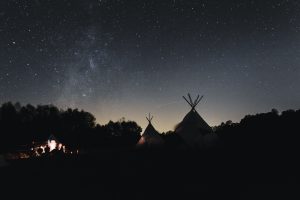When I think of Native Americans I am guilty of being influenced more by old cowboy films than real life. In my mind I see feather headdresses, redskins and peace pipes. I also hear the very haunting, smooth montage music as my ‘Indian Brave’ is at one with nature and sending smoke signals across the vastness of the landscape. I’m relieved to learn that the music, at least, is authentic.
As Elder is so easily hollowed out, the Native Americans would fashion branches of the tree into their famous Elderberry flutes and pan pipes. These beautiful instruments would produce the ducet yet haunting melodies that we so keenly associate with the American First Nations.
To me the music they produced conjures feelings of awe and wonder, of the vastness of the lands these Nomadic people once roamed. But the question I should be asking myself is, does it make me sleepy, or actually keep me awake?
According to one Miwok Legend, a guy called How Tol-le-loo wanted to steal some fire from a village. His plan was simple, he took with him an Elderberry Flute which he started playing as he entered the village, and soon enough everyone around him was falling asleep.
When the last person finally dropped off, Tol-le-loo crept over to the dying embers of the fire, and was just about to take them when a robin called Wit-ta-bah swooped down and covered the embers with his wings.

This doesn’t stop our man Tol-le-loo though. He whips out his flute and starts playing with it once again. Soon enough Wit-ta-bah is sound asleep, still covering the embers with his now reddened chest.
Rather than simply lifting up the little bird, Tol-le-loo decides to cut a hole in the poor little chap's wings and steal the fire that way. As Elder doesn’t burn very well, Tol-le-loo uses his flute to store the embers as he makes his escape from the village and up the mountains.
From another Miwok legend, the Birth of Wik'-Wek and the Creation of Man, we get this passage describing a single Elder tree, the Lah-pah, in the world at the dawn of time, located ‘where the sun goes up’ in the east and guarded by ‘a den of rattlesnakes’:
“Its branches, as they swayed in the wind, made a sweet musical sound. The tree sang; it sang all the time, day and night, and the song was good to hear. Wik'-wek looked and listened and wished he could have the tree. Nearby he saw two Hol-luk'-ki or Star-people, and as he looked he perceived that they were the Hul-luk mi-yum'-ko–the great and beautiful women-chiefs of the Star-people. One was the Morning Star, the other Pleiades Os-so-so'-li. They were watching and working close by the elderberry tree. Wek'-wek liked the music and asked the Star-women about it. They told him that the tree whistled songs that kept them awake all day and all night so they could work all the time and never grow sleepy. They had the rattlesnakes to keep the birds from carrying off the elderberries.”
Eventually, Wik'-wek secured some of the Elder tree which he planted across the country, offering the American Indian people food, music and medicine.
These wonderful stories go a long way to show just how important the Elder tree was to these people. As the medicinal value of the plant is dubious at best (interestingly used as a remedy for cold and flu on both sides of the pond, despite there being little scientific evidence that it works), and the flowers and berries being a great supplement to the diet, but never a main course, to the Native Americans the true magic of elder lay in it’s music.
Are you as enthralled by the magic of Elder folklore as we are? If so, why not pick up a copy of our new bestselling book: Elderflower Festival (you can buy it here). It's filled fascinating folklore, elderflower foraging tips and mouth-wateringly delicious recipes. It's the perfect pocket-guide companion to a summer of magic, foraging and flavour.